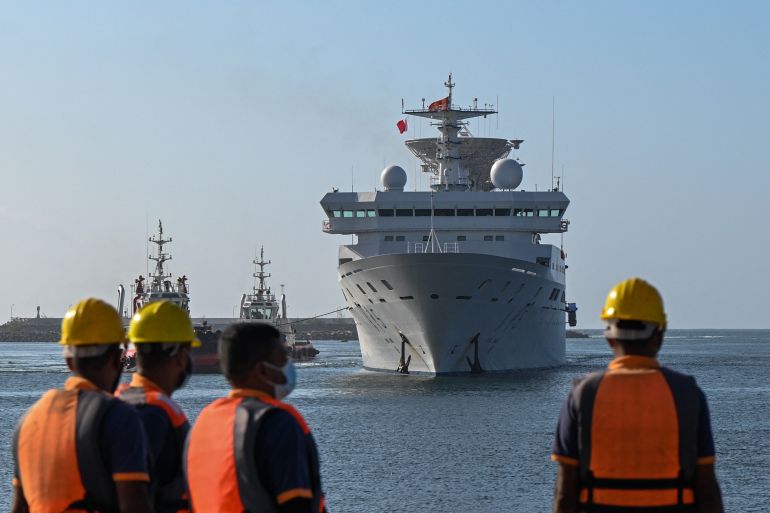Chinese survey ship docks in Sri Lanka after diplomatic standoff
Yuan Wang 5 arrives in Sri Lanka’s Hambantota port after a delay amid reported concerns from India and the US.

A Chinese research ship has docked at a Sri Lankan port after a days-long delay, reportedly because of concerns raised by India and the United States.
The Yuan Wang 5 entered Sri Lanka’s Hambantota port on Tuesday morning, and was welcomed by Chinese diplomats and port officials, according to the Colombo Gazette.
Keep reading
list of 4 itemsSri Lanka says controversial Chinese ship can dock
Former Sri Lanka president who fled homeland arrives in Thailand
End protest crackdown: UN, rights groups tell Sri Lanka president
The satellite tracking ship was initially scheduled to arrive in Hambantota port, a facility built and leased by Chinese companies and located on the southern tip of Sri Lanka, on August 11.
But the Sri Lankan foreign ministry deferred the five-day replenishment visit on August 8, citing “certain concerns”, apparently due to protests from New Delhi and Washington, according to media reports.
The Reuters news agency, citing a government source, said India objected to the ship’s visit, with Indian media describing the 730-foot vessel (222.5 metres) as a dual-use spy ship. The Pentagon, in its latest report on China’s military, had said the Yuan Wang vessels are operated by the Strategic Support Force of the People’s Liberation Army. It said the ships can be used to monitor satellite, rocket and ballistic missile launches.
India’s foreign ministry, however, rejected reports that it pressured Sri Lanka to turn the Yuan Wang away.
Arindam Bagchi, spokesman for India’s foreign ministry, said on Friday that “we reject categorically the ‘insinuation’ and such statement about India”. He added, “Sri Lanka is a sovereign country and makes its own independent decisions.”
The Washington Post, meanwhile, reported that US officials had also lobbied against the ship’s planned visit.
Citing a Sri Lankan government official, the Post said a Chinese navy ship arriving at Hambantota was not strategically significant, but that Indian and US officials had argued that it would be “viewed as Sri Lanka giving special treatment to China, a major creditor,” at a time when the country is grappling with its worst-ever economic crisis and trying to renegotiate its international debt.
China, which has been vying for influence in Sri Lanka, is the country’s largest creditor and has provided the country in the past with billions of dollars for development projects, including for the construction of the Hambantota port. Sri Lanka has since been struggling to repay the loans, and in 2017, handed over commercial activities at the $1.5bn port to a Chinese company for 99 years in exchange for debt relief. At the time, the move raised concern in India that China could use the port as a military base.
There was no official comment from the US on the Post’s claims.
Amid the diplomatic standoff, the Yuang Wang 5 reportedly reduced speed and turned around at sea, and China’s foreign ministry said it was “completely unjustified for certain countries to cite the so-called ‘security concerns’ to pressure Sri Lanka”.
It also urged “the relevant parties to see China’s marine scientific research activities in a rational light and stop disrupting normal exchange and cooperation between China and Sri Lanka”.
Ultimately, Sri Lanka’s foreign ministry on Saturday announced it had permitted a port call.
The ministry said in a statement that it had “engaged in extensive consultations at a high level through diplomatic channels with all parties concerned”.
The ship would be allowed to stay in Sri Lanka until August 22, it said, on the condition that it would keep its identification systems on and would not carry out any research activities in the country’s waters.
It added that its intention was to “safeguard the legitimate interests of all countries” and was thankful for the support from partners at a time when the country was trying to address its severe economic challenges.